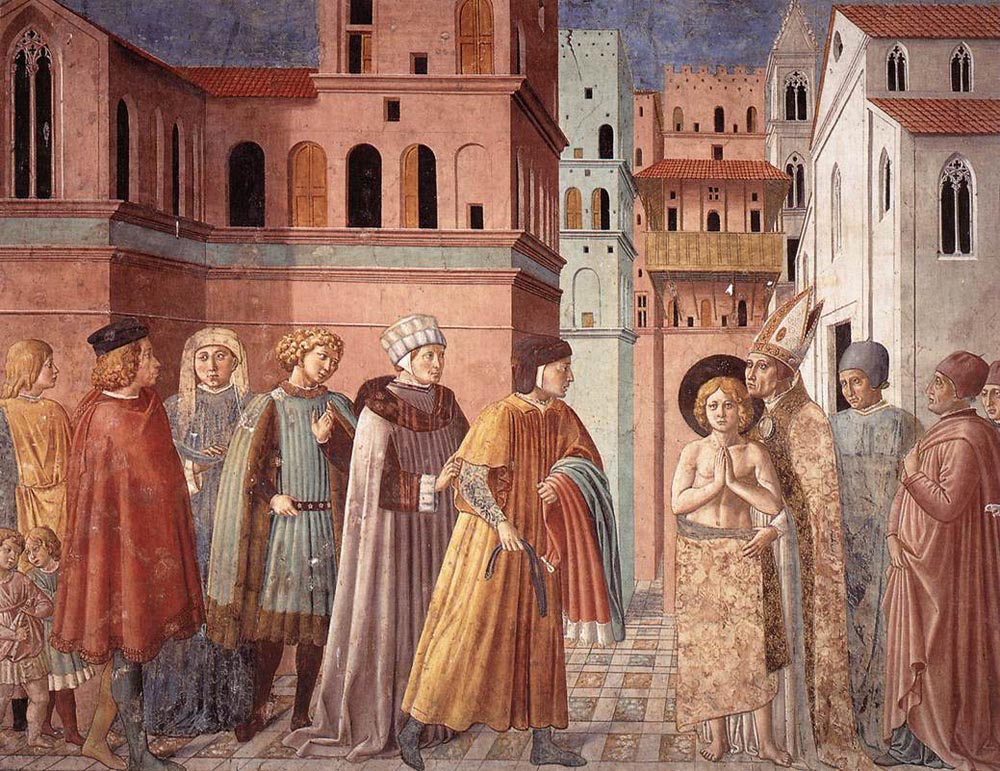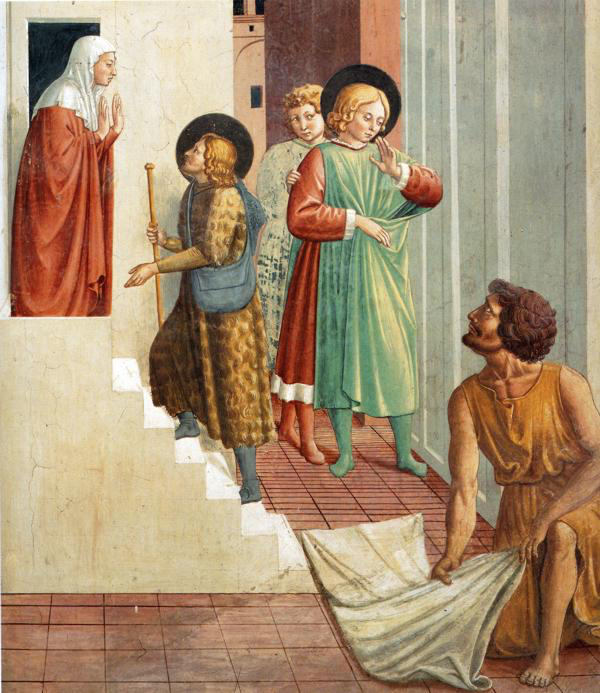The Search for Art II
Even with access to the complete works of the main artists patronized by Lorenzo de' Medici, I knew I didn't have enough figures to flesh out the world of the game. One major limitation of early Renaissance art is its subjects. Most of the subject matter is religious, with figures clad in what more-or-less amounts to classical bedsheets. Almost all the other figures are modern elites.
Obviously, since the player character of my game is a servant from the lower class, I needed to seek out paintings of the poor. I needed to find a figure to use as the player character, as well as lots of ordinary figures to populate the public spaces in the game like piazzas and outdoor markets. I began looking for images of servants in their livery, poor florentines, modern representations of biblical figures who are supposed to be poor, etc.
I went back to Wiki Art and searched for early Renaissance artists from Italy. Of these, I selected Paolo Uccello, Filippo Lippi, and Benozzo Gozzoli to add to my growing list of artists. I am already familiar with much of their art from my short time abroad in Florence. I have also read about Lippi's mentorship with Botticelli and Cosimo de' Medici's patronage of Gozzoli. These artists mesh well with the ones I've already gone through because of their artistic period and their relationship to Lorenzo de' Medici's father and grandfather.
Of the artwork I downloaded from Uccello, Lippi, and Gozzoli, I was able to find some useful figures. Let's start with the easier analysis: identifying the wealthy elites.

Detail from Gozzoli's Procession of the Magi
These figures are clearly wealthy 15th century elites. They are dressed in tunics made from sumptuous fabric over colorful tights. These figures are meant to be a part of the rich procession of the three super-wealthy and exotic kings from the east. However, historians have identified Cosimo de' Medici dressed in ordinary, understated clothing somewhere else in this painting that I have yet to find. Cosimo is known for dressing modestly to intentionally avoid the attention that comes with wealth as part of his political strategy. Comparing the figure in the foreground of the detail above with the representation of Cosimo in the same fresco will help be differentiate between elites that do or do not show off their status.

Gozzoli's Renunciation of Worldly Goods from his St. Francis Cycle
In this Gozzoli piece, St. Francis tears off his father's clothes. He renounces materialism and embraces poverty then is covered by the bishop in an act of protection and modesty. To the left, his wealthy merchant father holds Francis' clothes, protesting his renunciation of his inheritance. By knowing the story behind the painting, we can learn a lot about the figures depicted. Specifically, we can learn that wealthy merchants like St. Francis' father and his companions might be shown in other paintings wearing fashionable caps and long colorful capes over their tunics. Francis' act of disrobing to embrace poverty tells us more than simply that the poor don't dress like the rich. It tells us that the poor own less clothing. They have to wear it more often in between infrequent washings, which means it will be dirtier, and they will have less variety in what they wear because they have fewer options.
Now let's turn our attention to images of the lower class.

Uccello's Stoning of St. Stephen
To the far right of this image, there is a man in a red tunic with a stone in his hand. He contrasts with the rest of the figures in this image in two ways. First, the wrinkles around his neck make his skin looks worn and leathery, as if he's had to spend more time out in the hot Florentine sun. Second, he wears less clothing than the rest of the crowd. His tunic is split down the front to reveal an undergarment, and he is missing sleeves entirely. Further, he is one of only a few figures not to wear a cap on his head. His position on the edge of the scene indicates his peripheral status, not only to the story of St. Stephen's martyrdom, but also as an outsider to the upper class, who have the privileged of being painted in the center of a famous religious scene. All the signs point to this man being poor.

Detail from Gozzoli's Birth of St. Francis
Just like in the Stoning of St. Stephen, the man in yellow is differentiated from the elites in the scene by his appearance. He wears a simple yellow tunic without any sleeves. He has no cap, cape, tights, or even shoes, unlike the other figures. His skin is darker, too, indicating he has to spend more time working outside than the pale figures in fancy, complicated attire. In addition to his appearance, he is posed in an act of service. He is on his knees working with a cloth on the floor. What he is doing with it is unclear, but he is clearly working while the other people are not.
This close examination of Renaissance art for specific kinds of figures was an interesting and fruitful exercise. I have a better idea now of how I think the lower class dressed in 15th century Florence based on how the poor are depicted in contemporary art. It seems the poor have less clothing, and certainly less interesting fabrics, than their wealthy contemporaries. This may be due to the lucrative nature of the wool market in Florence at this time, or to the expensive nature of pre-industrialization fabrics in general. In any case, this knowledge helps me identify class in Renaissance art, which I can translate into my game.
Get The Pazzi Conspiracy: An Educational Video Game
The Pazzi Conspiracy: An Educational Video Game
a historical game to teach university students about the Italian Renaissance
| Status | Released |
| Author | Haley Price |
| Genre | Educational |
| Tags | 2D, Historical, Point & Click, Story Rich |
More posts
- Install InstructionsOct 08, 2021
- Video ExegesisMay 13, 2021
- CitationsMay 07, 2021
- Writing a Teaching Guide IIMay 06, 2021
- Writing a Teaching GuideMay 06, 2021
Leave a comment
Log in with itch.io to leave a comment.